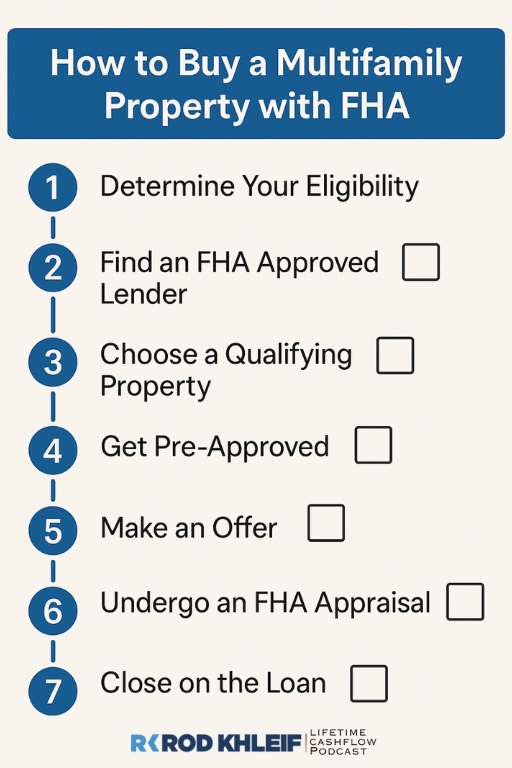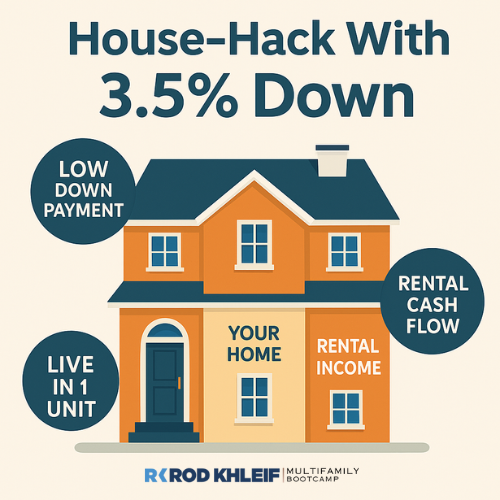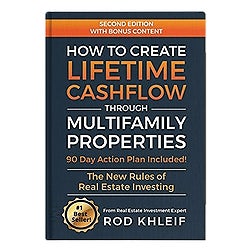For real estate investors looking to enter the multifamily market with minimal upfront capital, FHA multifamily loans can be an excellent way to get multifamily financing. These loans are backed by the Federal Housing Administration (FHA) and the Department of Housing and Urban Development (HUD). They offer easy terms for buyers. However, buyers much purchase 2-4 unit homes. They can live in one unit as their main home.
In this comprehensive guide, we’ll cover what multifamily loans are, how to qualify, their benefits and drawbacks, and strategies for maximizing their potential.
What is an FHA Multifamily Loan?
An FHA multifamily loan is a government backed mortgage. Unlike traditional investment property loans, FHA multifamily loans require the borrower to occupy one of the units as their primary home for at least one year. This is often referred to as owner occupied.
While FHA loans to buy multifamily properties don’t directly come from the government, they are insured by the FHA, which reduces risk for lenders and allows them to offer favorable loan terms. This makes it a desirable multifamily financing.
Key Features of FHA Multifamily Loans:
- Down Payment as Low as 3.5%: Compared to conventional loans, which often require 20-25% down, an FHA loan for multifamily property requires as little as 3.5% down for qualified borrowers.
- Fixed-Rate Mortgages Available: Borrowers can choose from 15-year or 30-year fixed-rate mortgages, offering stability in payments.
- Lower Interest Rates: FHA backed loans often come with lower interest rates than conventional loans.
- Flexible Credit Score Requirements: FHA loans are available to borrowers with credit scores as low as 580.
- Higher Loan Limits: The FHA loan limits for multifamily properties vary by location but are higher than those for single-family homes.
- Seller Concessions: Sellers can contribute up to 6% of the purchase price toward closing costs, reducing upfront expenses for buyers.
FHA Multifamily Loan Requirements
Before applying, borrowers must meet the FHA multifamily loan requirements, which include financial and occupancy criteria:
Financial Requirements:
- Credit Score: Minimum 580 for 3.5% down payment or 500-579 with 10% down.
- Debt-to-Income Ratio (DTI): FHA loans typically require a DTI ratio of 50% or less, meaning your total monthly debt obligations should not exceed 50% of your gross income.
- Employment and Income: Borrowers must demonstrate a steady income and at least two years of employment history.
- Loan Limits: The FHA loan limits for multifamily properties depend on location and are adjusted annually.
Occupancy Requirements:
- The borrower must live in one of the units as their primary residence for at least one year.
- The property must have between 2 and 4 units. Larger properties (5+ units) do not qualify under standard FHA multifamily loan guidelines.
Property Standards:
- The property must meet HUD’s safety and livability requirements.
- An FHA approved appraiser will inspect the home to ensure it meets minimum property standards before the loan is issued.
How to Buy a Multifamily Property with FHA

If you’re wondering how to buy multifamily property with FHA, here’s a step by step guide:
Step 1: Determine Your Eligibility
Check your credit score, income stability, and existing debts to ensure you meet FHA loan requirements.
Step 2: Find an FHA Approved Lender
Not all lenders offer FHA multifamily financing, so it’s important to find a lender with experience in FHA multifamily loans.
Step 3: Choose a Qualifying Property
- The property must be between 2 and 4 units.
- One unit must be occupied by the borrower as a primary residence.
Step 4: Get Pre-Approved
A pre-approval letter from an FHA lender will show sellers that you’re a qualified buyer.
Step 5: Make an Offer
Once you find a qualifying property, work with your real estate agent to negotiate an offer.
Step 6: Undergo an FHA Appraisal
The FHA approved appraiser will assess the home’s value and ensure it meets FHA multi unit guidelines.
Step 7: Close on the Loan
Upon final approval, close on your loan and move into one of the units as your primary residence.
Advantages and Disadvantages of FHA Multifamily Loans
Pros:
- Low Down Payment: 3.5% down makes entry into real estate investing accessible.
- Lower Interest Rates: Compared to conventional investment loans.
- Easier Qualification: Less stringent credit score and income requirements.
- Seller Concessions Allowed: Helps reduce closing costs.
- Build Wealth Through Rental Income: Other units generate cash flow to offset mortgage payments.
Cons:
- Mortgage Insurance Required: Upfront and monthly PMI payments add to costs.
- Owner-Occupancy Requirement: Borrower must live in one of the units.
- Property Restrictions: Must meet HUD’s safety and livability standards.
- Loan Limits Apply: The maximum loan amount varies by county and state.
FHA vs. Conventional Loans for Multifamily Properties
| Feature | FHA Multifamily Loan | Conventional Multifamily Loan |
|---|---|---|
| Down Payment | 3.5% | 15-25% |
| Interest Rates | Lower | Higher |
| Credit Score Requirement | 580+ | 680+ |
| Owner-Occupancy | Required | Not Required |
| Mortgage Insurance | Yes | No (if LTV < 80%) |
| Property Condition | Must meet FHA standards | More flexible |
Is an FHA Multifamily Loan Right for You?
An FHA multifamily loan is a great option for new investors. It helps them enter the multifamily real estate market. This loan offers low down payments and flexible lending terms. If you meet the owner-occupancy requirement and follow FHA loan rules, this loan can help you build wealth.
Take the Next Step
- Speak with an FHA approved lender to assess your eligibility.
- Research FHA loan limits in your area.
- Find a multifamily property that meets FHA multi unit guidelines.
Rod Khleif’s Expert Take: Why This Strategy Can Change Your Financial Future
Listen, if you’ve been dreaming of getting into multifamily real estate but thought you needed deep pockets, I’m here to tell you that an FHA multifamily loan could be the smartest move you ever make. I’ve coached thousands of investors, and time and again, I’ve seen people start with just 3.5% down, buy a 2-4 unit investment property, live in one unit, and let their rental properties cover their mortgage. That’s house hacking at its finest.
But here’s what makes it even more powerful, you’re not just reducing your housing costs, you’re actually building equity while someone else pays down your mortgage. This isn’t just about buying a primary residence, it’s about creating long-term wealth with cash-flowing assets that appreciate over time.
And if you’re worried about mortgage insurance or FHA loan restrictions, let me remind you: these are minor trade offs compared to what you’re gaining- a low-cost entry into multifamily investing, a chance to learn the business firsthand, and an opportunity to set yourself up for bigger deals in the future.
I started my journey in real estate with a small property, and it completely transformed my life. I’ve been through market cycles, seen interest rates rise and fall, and coached investors who’ve used this very strategy to build incredible portfolios.
So my advice? Don’t overthink it. If you’re serious about building wealth, take action. Talk to an FHA approved lender, find a qualifying property, and start your journey today. The sooner you get started, the sooner you’ll be on your way to financial freedom.
And remember, this is just the beginning. The goal isn’t to live in your investment property forever. It’s to use this stepping stone to leverage into bigger deals, short term rentals, or even commercial real estate.
If you’re ready to take control of your financial future, let’s make it happen. Check out my free resources, or grab a copy of my book, and let’s start building your legacy in multifamily real estate.
For more expert insights, follow Rod on Instagram.
Want a Step-by-Step Guide to Multifamily Investing?
Discover how top real estate investors build massive cash flow and financial freedom with multifamily real estate. In his book, How to Create Lifetime Cash Flow with Multifamily Real Estate Investing, Rod Khleif shares proven strategies to find deals, raise capital, and scale fast.
📘 Get Your Copy Here: Order the Book
By using FHA loans to buy multifamily, you can start building a strong real estate portfolio with minimal upfront investment and steady rental income!
FHA Multifamily Loans FAQ
What exactly is an FHA multifamily loan?
An FHA multifamily loan is a mortgage insured by the Federal Housing Administration and overseen by HUD. Unlike traditional investment loans, these loans are designed for smaller properties—specifically 2–4 unit homes—and they come with a key condition: you, as the borrower, must live in one of the units for at least a year. That makes this program different from purely investment-focused financing. Because the loan is backed by the government, lenders face less risk, which allows them to offer much lower down payment requirements and more flexible qualification standards than you’d see with conventional multifamily financing.
Who can qualify for FHA multifamily loans?
Qualifying isn’t as difficult as many first-time investors assume. You generally need a credit score of at least 580 to put only 3.5% down, though scores between 500–579 are sometimes accepted with 10% down. You’ll also need a stable income history—usually two years of consistent employment—and a debt-to-income ratio below about 50%. Another requirement is occupancy: you must plan to live in one of the units as your primary residence for at least twelve months. That’s why FHA multifamily loans are often described as perfect for “house hacking.”
How many units can you purchase with FHA financing?
These loans are strictly for small-scale multifamily: duplexes, triplexes, and fourplexes. If you’re thinking of buying an apartment building with five or more units, that falls outside FHA’s standard program and would require other financing such as FHA’s 223(f) multifamily loan program or traditional commercial loans.
What’s the minimum down payment for FHA multifamily loans?
This is one of the biggest draws. While conventional loans often demand 20–25% down on multifamily properties, FHA multifamily financing lets qualified borrowers in for as little as 3.5%. On a $400,000 fourplex, that’s a $14,000 entry point—something that has allowed countless first-time investors to break into real estate with limited capital.
Do FHA multifamily loans have income restrictions?
Unlike some first-time homebuyer programs, FHA multifamily loans don’t set a ceiling on how much you can earn. Instead, the focus is on whether your income is stable and sufficient to support the mortgage payments once the rental income from other units is factored in. Lenders also verify that your total debts—including the new mortgage—don’t exceed about half of your gross income.
What are the main benefits of FHA multifamily loans?
The advantages are clear for new investors. First, the low down payment dramatically lowers the barrier to entry. Second, FHA loans typically carry lower interest rates than comparable conventional loans, which keeps monthly payments manageable. Third, sellers can contribute up to 6% of the purchase price toward closing costs, further reducing your out-of-pocket expenses. Finally, you can use the rental income from the other units to offset your mortgage—essentially allowing your tenants to help pay down your loan while you live on-site.
What are the drawbacks?
There are tradeoffs. FHA loans require both upfront and monthly mortgage insurance premiums, which increase your carrying costs. You’ll also be obligated to live in the property for at least a year, which might not fit every investor’s goals. The property itself has to meet strict HUD safety and livability standards, so fixer-uppers with major issues may not qualify. Finally, FHA loan limits vary by county, so in expensive markets you may find yourself capped at a loan amount that doesn’t buy much property.
Can rental income help you qualify?
Yes. One of the more investor-friendly features of FHA multifamily loans is that the projected rental income from the units you don’t occupy can be used to help you qualify. Lenders will often allow a percentage of the expected rents to count toward your income when calculating your debt-to-income ratio. This makes it easier for borrowers to qualify for larger properties than they might be able to on their salary alone.
How do FHA multifamily loans compare with conventional loans?
Think of FHA as the “low barrier entry point” and conventional as the “step-up option.” FHA allows you in with 3.5% down, a 580 credit score, and below-market interest rates—but requires mortgage insurance and owner-occupancy. Conventional loans usually need 15–25% down and higher credit scores, but they don’t require you to live in the property and they avoid mortgage insurance once you have at least 20% equity. For investors planning to buy strictly as landlords, conventional may be better. For new investors trying to get in the game with minimal cash, FHA is often unbeatable.
Is this program really good for first-time investors?
Absolutely. FHA multifamily loans are considered one of the best stepping stones into real estate investing. You can live in one unit, learn property management firsthand, build equity, and allow rental income to offset much of your housing expense. Over time, once the one-year occupancy requirement has been met, you can move out and convert all the units into rentals. Many successful investors began their journey exactly this way.
What happens after you’ve lived in the property for one year?
Once you’ve fulfilled the owner-occupancy requirement, you’re free to move out and rent your unit. At that point, the property becomes a fully income-producing investment. Many investors then use the equity they’ve built and the experience they’ve gained to purchase larger properties, refinance into conventional loans, or branch into short-term rentals or commercial real estate. In other words, FHA multifamily loans are rarely the final stop—they’re the launch pad
Disclaimer: This article was written with the help of AI and reviewed by Rod’s team. Always consult a licensed professional.



